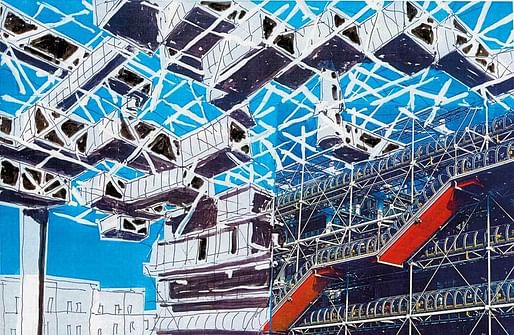
Yona Friedman, the Hungarian-born French Jewish architect who helped develop the concept of "mobile architecture" in the 1960s and 70s, has passed away at age 96.
Friedman was born in 1923 and grew up during the Nazi era. Due to the fact that universities in Budapest had imposted strict admissions quotas against Jewish students at the time, Friedman was forced to acquire his architectural education though somewhat clandestine means. He sat in on classes and was never allowed to take exams, all the while receiving tutoring from other luminaries of the time, including the famous German physicists Werner Heisenberg. After fleeing Europe during World War II, he lived in Israel for a decade and then moved France, where he settled permanently and attained citizenship in 1966. During these years, Friedman developed some of his most potent ideas and proposals.

He is widely known for his imaginative paper architecture visions that blended Metabolist, High-Tech, and Futurist tendencies to envision massive technological tapestries that brought a certain type of utopian urbanism to life. For Friedman, despite the monumental scale of his proposals, architecture's role was one of stepping back and facilitating human life. His vision of "mobile architecture" from 1958, for example, focused on creating a new form of "dwelling decided on by the occupant" that was subtly shaped by a back-and-forth relationship between structure and user in a long-term process designed to facilitate change over time. To suit this vision, he envisioned a network of open scaffolding and masted structures that could be infilled and repositioned as need be. The concept would lay the groundwork for later experiments in self-construction, automatic urbanism, and other intellectual movements in urban and architectural design.
Later, Friedman expanded this notion to the urban scale "Spatial City" (Ville Spatiale) concept, creating massive matted structures lifted off the ground on thick piloti that allowed these new neighborhoods to touch down with the smallest footprint possible. These designs offered a solution for densifying existing cities without necessarily having to destroy existing historic fabric and for limiting the horizontal sprawl of urban areas, an idea that certainly came before its time. Friedman even developed a type of computer game called the "Flatwriter" that allowed a user to design the plan their home within the Ville Spatiale and even, to propose district-scale ideas for reconfiguring these new neighborhoods.

In later years, Friedman worked to apply his ideas on self-construction and infrastructural architecture through work in the developing world and on humanitarian housing. He worked with the United Nations and UNESCO to create disaster and self-built housing in India and across the African continent, for example, always pushing toward his concept of the Utopies Réalisables, or "feasible utopias."
Additionally, in 2016, Friedman was commissioned to design a Summer House for the Serpentine Galleries in London. The installation, built up out of steel cubes made out of circular profiles, built on Friedman's auto-construction experiments that utilized hoollahoops to build triumphal arches and other sculptural objects.
An Instagram post from the @yona_friedman account announced the designer's passing this week. The message reads: After 96 years on this earth, Yona has moved up to build a Spatial City and install some Space Chains in the sky. The Fonds de Dotation Denise and Yona Friedman, which he founded last year, will continue his work.
2 Comments
Yona was my jam while writing up my M.arch thesis. This is very sad. Loved his stuff.
Personal loss for me. Yona is my Guru. Very fortunate to work with Yona in Paris - in his House - on a real project - which he did for Compagnie Dubonnet Cinzano (CDC) in Ivry Sur Seinne, - because the Client agreed to implement Yona's mobile architecture principles.
May His Soul RIP.
Block this user
Are you sure you want to block this user and hide all related comments throughout the site?
Archinect
This is your first comment on Archinect. Your comment will be visible once approved.